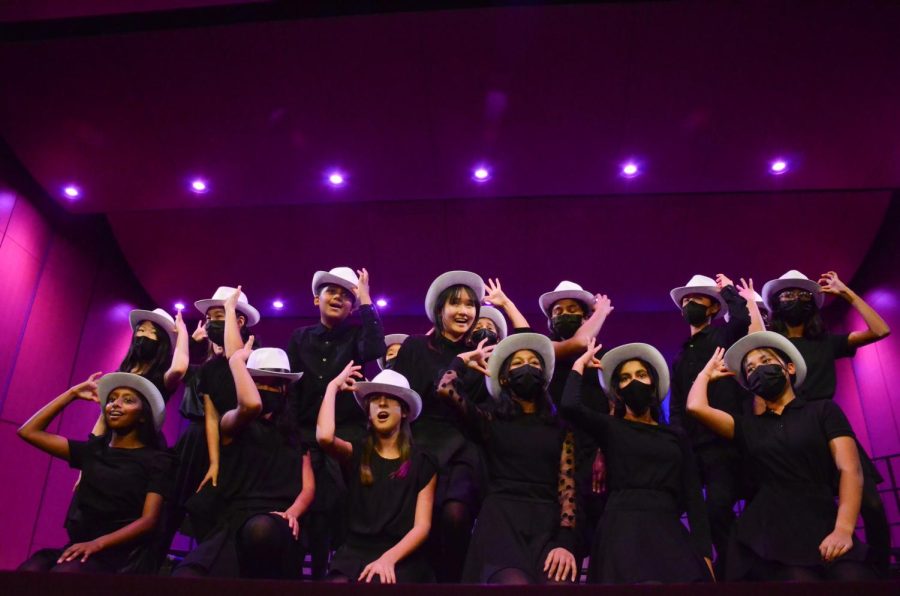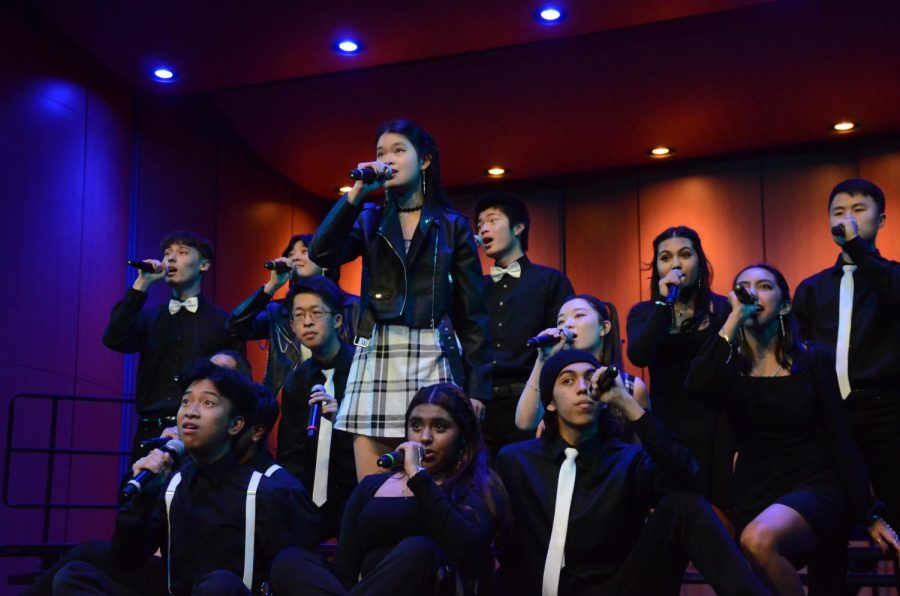United Voices strike a chord
Harmonics poses at the end of “Lullaby of Birdland.” The middle school show choir performed with white hats, dancing across the stage and weaving through formations.
At a school like Harker, distance is inevitable. It hides between campuses, between ages and between the cracks left by the pandemic. United Voices, held on March 3 for the first time since 2018, examines what it means to bridge those gaps.
Upper, middle and lower school choirs performed in a two-hour-long showcase of Harker’s vocal talents. Opening the show was the lower school Concert Choir performing “Dona Nobis Pacem” by Mary Donnelly and arranged by George L.O Strid. They then performed “When I Grow Up” from Tim Minchin’s “Matilda.” Stomping their feet and exaggerating their discontent, the lower schoolers left the audience chuckling as Dynamics, the grade 6 choral ensemble, took the stage.
“When nine and 10-year-olds perform, they’re so genuine,” upper school vocal music teacher and concert organizer Jennifer Sandusky said. “I asked [the older kids] to watch them during rehearsal and bring that inner child with them when they go into their own performances. The way young children learn and get into their endeavors can be very informative for us.”
Dynamics, led by the energetic conductor Kristin Pfeifer, performed “Kusimama” by Jim Papoulis. Following them was Razzmatazz, the middle school’s new male-identifying ensemble, performing “Storm” by James DesJardins, accompanied by a drum bigger than the middle schooler playing it. During the dress rehearsal, members of both ensembles forgot to take their entrances, having to be shepherded onstage by the tech crew.
“At first, mistakes are something we laugh at,” upper school vocal teacher Susan Nace said. “When the concert gets closer, those mistakes hurt a little more. When there are mistakes, when everyone may feel shame or disappointment, it’s lovely to see people go ‘That’s okay. You can do this. I’m going to lift you up.’”
Harmonics performed Roger Emerson’s arrangement of “Lullaby of Birdland” by George Shearing. The middle school show choir performed with white hats, dancing across the stage and weaving through formations. Vivace, the middle school treble choir, followed with “Poor Wayfaring Stranger.” Closing off the middle school portion of the show was the middle school Concert Choir, a grade 7-8 ensemble, with Christi Jones’s “Awakening.”
Led by Susan Nace, Dolce Voce performed “What Happens When a Woman?” by Alexandra Olsavsky. An upper school alto and soprano ensemble which debuted in the 2022 fall concert, Dolce Voce prepared this song by first discussing what being a woman today means to them. Section leader Saanvi Bhargava (10) discusses what translating the emotions and concepts discussed to actual performance takes for her.
“It starts with getting out of just memorizing the song,” Saanvi said. “I figured out what the piece meant to me and found a specific point of view. I started to really feel the song and incorporating that into the body percussion and the actual singing.”
As singers in upper school advance, the focus of their vocal experience shifts to be able to understand the piece beyond, in Nace’s words, “just dots on the page or pretty sounds”. She speaks about the development of her singers throughout the year.
“Every teacher teaches to see growth,” she said. “Not to see perfection, but to see possibilities unfold, which the students often exceed. [Throughout the year] I see refinement of maturity, not just vocally but as people, of their musicianship, them connecting to others for a common goal, and of their leadership.”
Rhapsody, the upper school tenor and bass ensemble, joined Dolce Voce onstage to form Festival Chorus. They performed Donald Patriquin’s arrangement of “Savory, Sage, Rosemary, and Thyme,” a Canadian folk song, together. Upper school English teacher Christopher Hurshman and Ipsita Mandal (11) then accompanied Rhapsody for “All the Diamonds” by Bruce Cockburn, arranged by Larry Nickel.
Razzmatazz and Downbeat’s tenors and basses then squeezed into the risers with Rhapsody for “The Wellerman,” a New Zealand sea shanty, popping up and down to the delight of the audience. Cantilena then followed with a reprise of the opener “Dona Nobis Pacem” and “Magic Song for One Who Wishes to Live from ‘Three Songs of Light.’
“[Magic Song] is a ritual song from the Inuit people,” Nace said. “It’s a song hoping that someone [you] love will choose to live. We’ve shared stories about what it’s like to be in a room with someone who is dying or someone who is so critically ill you don’t know if they’re going to live. It’s hard to bring out those personal feelings, yet at the same time when we sing, we sing about life. To express humanity.”
Downbeat, the upper school show choir led by Laura Lang-Ree and Sandusky, was the penultimate act, performing “Just a Girl” by No Doubt and “Pure Imagination” from Willy Wonka. These were two out of three songs in their setlist for the ICHSA (International Championship of High School A Cappella) quarterfinals Mar. 10. Sharp choreography and costumes combined with the strong vocals of the group spoke to the countless hours poured into the act. Sandusky speaks about the work put into the setlist.
“[Preparing arrangements] is like an essay,” she said. “You’re going to have to make revisions. We all sat and went through ideas and shifted voice parts. [Just A Girl] needed a lot of wood shedding to get it where we needed it to be, but it ended up being a great learning experience.”
For the finale, all the choirs congregated on the stage, spilling out of the risers, for two songs: “The Harker School Song” and “Up on the Mountain Shouting,” a rousing gospel featuring Sandusky stomps, lower schooler dances, thunderous claps and cheers all around.
“A gospel piece can be difficult with people of all different ages,” Shayla said. “Everyone’s at different levels of vocal training, but it’s important that kids in the lower and middle schools have this exposure to what it means to sing at a higher level. At the same time, [upper schoolers] can return to our childhood and the joy we had singing in lower or middle school.”
Seniors Ava Arasan, Lucy Feng, Kris Estrada and Samvita Gautham, all spoke between every three to four songs about their experiences in the Harker vocal program. Kris, who joined Harker in 9th grade, spoke about the community he found in the program.
“My favorite [piece] is the Harker school song,” Kris said. “There’s a video online of all the Harker choirs singing the song together in 2018. Since then there has not been this type of uniting piece where everyone comes together to sing and share an emotion. It’s our school’s alma mater and I’m excited to hear that for the first time it’s been performed with [singers from all schools] since 2018.”
Though the ensemble’s time all together was small, the bonds of mentorship, friendship and admiration formed readily. When blocking pieces, upper schoolers would often drag younger kids to their positions. Other times, curious lower schoolers would randomly approach older singers with questions. Crew member Hannah Levanon (10) describes watching rehearsals.
“There’s something about these large casts you don’t get with other [productions],” she said. “It’s sweet to see everyone in the audience watching during rehearsal. Especially with the little kids, you see them genuinely supporting their friends, their big sibling, the older sibling of a friend, or just some random people who probably seem like adults to them.”
To eschew the unique identities of each campus, choir and student in the pursuit of zero difference would be foolish. However, great beauty can be found when those individual components are brought together and worked towards, in the words of Sandusky, “the service of something bigger than [themselves]”.
“I would liken [United Voices] to a musical chord,” Kris said. “Chords have beautiful and intricate notes that, when coming together, sound beautiful. All of the Harker choirs coming together, how much passion and complex harmonies we can create, it’s something unlike anything I’ve ever seen.”

Alison Yang (12) is an Editor-in-Chief of Harker Aquila, and this is her fourth year on staff. This year, she looks forward to bonding with everyone on...


















![“[Building nerf blasters] became this outlet of creativity for me that hasn't been matched by anything else. The process [of] making a build complete to your desire is such a painstakingly difficult process, but I've had to learn from [the skills needed from] soldering to proper painting. There's so many different options for everything, if you think about it, it exists. The best part is [that] if it doesn't exist, you can build it yourself," Ishaan Parate said.](https://harkeraquila.com/wp-content/uploads/2022/08/DSC_8149-900x604.jpg)




![“When I came into high school, I was ready to be a follower. But DECA was a game changer for me. It helped me overcome my fear of public speaking, and it's played such a major role in who I've become today. To be able to successfully lead a chapter of 150 students, an officer team and be one of the upperclassmen I once really admired is something I'm [really] proud of,” Anvitha Tummala ('21) said.](https://harkeraquila.com/wp-content/uploads/2021/07/Screen-Shot-2021-07-25-at-9.50.05-AM-900x594.png)







![“I think getting up in the morning and having a sense of purpose [is exciting]. I think without a certain amount of drive, life is kind of obsolete and mundane, and I think having that every single day is what makes each day unique and kind of makes life exciting,” Neymika Jain (12) said.](https://harkeraquila.com/wp-content/uploads/2017/06/Screen-Shot-2017-06-03-at-4.54.16-PM.png)








![“My slogan is ‘slow feet, don’t eat, and I’m hungry.’ You need to run fast to get where you are–you aren't going to get those championships if you aren't fast,” Angel Cervantes (12) said. “I want to do well in school on my tests and in track and win championships for my team. I live by that, [and] I can do that anywhere: in the classroom or on the field.”](https://harkeraquila.com/wp-content/uploads/2018/06/DSC5146-900x601.jpg)
![“[Volleyball has] taught me how to fall correctly, and another thing it taught is that you don’t have to be the best at something to be good at it. If you just hit the ball in a smart way, then it still scores points and you’re good at it. You could be a background player and still make a much bigger impact on the team than you would think,” Anya Gert (’20) said.](https://harkeraquila.com/wp-content/uploads/2020/06/AnnaGert_JinTuan_HoHPhotoEdited-600x900.jpeg)

![“I'm not nearly there yet, but [my confidence has] definitely been getting better since I was pretty shy and timid coming into Harker my freshman year. I know that there's a lot of people that are really confident in what they do, and I really admire them. Everyone's so driven and that has really pushed me to kind of try to find my own place in high school and be more confident,” Alyssa Huang (’20) said.](https://harkeraquila.com/wp-content/uploads/2020/06/AlyssaHuang_EmilyChen_HoHPhoto-900x749.jpeg)





